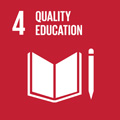- Docente: Sonia Cavicchioli
- Credits: 6
- SSD: L-ART/02
- Language: Italian
- Teaching Mode: In-person learning (entirely or partially)
- Campus: Bologna
- Corso: First cycle degree programme (L) in Humanities (cod. 8850)
-
from Sep 16, 2024 to Oct 23, 2024
Learning outcomes
The course proposes to form for the students an adequate knowledge of the base of the principle facts and crucial questions of art overall Italian from the 15th century to the end of the 18th century. In particular the ability to recognize essential technical methods that would allow the student to understand the work of art from the point of view of the style and the form, the iconography, technique and to comprehend the connections to the historical, social and cultural timeframe in which they were produced. At the end of the course the student should be familiar with the characteristic themes and particularities along with the ambitions of the artists of these centuries. The student should also recognize and be able to comment on the works of the most representative artists and movements.
Course contents
Il corso intende in primo luogo fornire a studentesse e studenti gli strumenti per la lettura delle opere d’arte, presentandole nella loro specificità. Prevede pertanto un momento iniziale di introduzione del metodo storico-artistico, che sarà propedeutico anche allo studio del manuale e alla preparazione dell’esame, in particolare lo scritto. Il secondo obiettivo è portare alla luce gli elementi fondamentali dell’arte (in realtà delle arti: pittura, scultura, architettura e non solo) di età moderna, evidenziandone la continuità nei secoli dal XV all’inizio del XIX. Per farlo il corso si concentrerà su alcuni snodi, movimenti, artisti di particolare interesse puntando a guardare la storia dell’arte in prospettiva bolognese.
Students with SLD or temporary or permanent disabilities
It is suggested that they get in touch as soon as possible with the relevant University office (https://site.unibo.it/studenti-con-disabilita-e-dsa/en) and with the lecturer in order to seek together the most effective strategies for following the lessons and/or preparing for the examination
Readings/Bibliography
Handbbok
Salvatore Settis e Tomaso Montanari, Arte. Una storia naturale e civile, Milano, Mondadori Education, vol. 3, Dal Quattrocento alla Controriforma e vol. 4, Dal Barocco all’Impressionismo
Copia del manuale si trova presso:
- Biblioteca “Raimondi”, sezione di Studi Umanistici
- Biblioteca delle Arti, sezione Arti viive “Supino”
- Biblioteca di Lingue, letterature moderne
List of books:
Rinascimento e arte del XVI secolo
Arte e umanesimo a Bologna. Materiali e nuove prospettive, a cura di D. Benati e G. Calogero, Bologna, BUP, 2019, pp. 1-294 (I e II parte)
A. Pinelli, La bella maniera, Torino, Einaudi, 1993
J. Shearman, Funzione e illusione, Milano, Il Saggiatore, 1983
V. Farinella, Raffaello pittore archeologo. Eguagliare e superare gli antichi, Roma, Carocci, 2021
R. Wittkower, Principi architettonici nell'età dell'Umanesimo (1962), Torino, Einaudi, 1994
M. Tafuri, Ricerca del Rinascimento, principi, città, architetti, Torino, Einaudi, 1992
A. Pinelli, La bellezza impura: arte e politica nell'Italia del Rinascimento, Bari, Laterza, 2004
G.C. Argan, B. Contardi, Michelangelo architetto, Milano 1990
F. Zeri, Pittura e Controriforma. L'Arte senza tempo di Scipione da Gaeta, Torino, Einaudi, 1957
Nell'età del Correggio e dei Carracci, cat. della mostra, Bologna 1986 (i saggi alle pagg. XV – XXXI, 3-20, 31-44, 213- 254, 355-367 e le schede delle opere di Correggio, di Parmigianino e dei Carracci)
P. Prodi, Arte e pietà nella Chiesa tridentina, Bologna, Il mulino, 2014
Seicento
R. Longhi, Caravaggio (1951), Milano, Martello (anche nelle ristampe Martello o Editori Riuniti)
F. Bologna, L’incredulità di Caravaggio e l’esperienza delle “cose naturali”, Torino, Bollati Boringhieri, (1992), 2006
A. Zuccari, Caravaggio controluce. Ideali e capolavori, Milano, Skira, 2011 (premessa dell’autore, e pp. 187-284).
Roma 1630. Il trionfo del pennello, catalogo della mostra, Milano, Electa, 1994, saggi di G. Briganti, M. Fumaroli, O. Bonfait, S. Ebert-Schifferer, O. Bonfait (pp. 23-126) e, nel catalogo, schede dei dipinti alle pp. 128-181
P.Portoghesi, Roma barocca (1966), Bari, Laterza 1978 (vol.I)
T. Montanari, La libertà di Bernini, Torino, Einaudi, 2016
E. Mâle, L'arte religiosa nel Seicento, ed. it. Milano Jaca Book, 1984
S. Cavicchioli,"L'Aquila e 'l Pardo". Rinaldo I e il mecenatismo di casa d'Este nel Seicento, Modena, Franco Cosimo Panini, 2015
S. Alpers, Arte del descrivere. Scienza e pittura nel Seicento olandese, Boringhieri, 1984: in particolare l'Introduzione e i capitoli 3, 4 e 6
S. Schama, La cultura olandese nell'epoca d'oro, Milano, Mondadori, 1988
M. Fumaroli, La scuola del silenzio, Milano, Adelphi, 1995, cap. I: “Il Parnaso romano”, pp. 13-209
Settecento e primo Ottocento
J. Starobinski, La scoperta della libertà, Ginevra, Skira 1964
O. Rossi Pinelli, Le arti nel Settecento europeo, Torino, Einaudi, 2009
L. Barroero, Le Arti e i Lumi. Pittura e scultura da Piranesi a Canova, Torino, Einaudi, 2011
A. Ottani Cavina, I paesaggi della ragione, Torino, Einaudi, 1994
R. Rosenblum, Trasformazioni nell'arte. Iconografia e stile tra Neoclassicismo e Romanticismo, Roma, La Nuova Italia Scientifica 1984
S. Cavicchioli, Dipingere pensieri. Francesco IV d’Austria-Este e la decorazione del Palazzo Ducale di Modena (1814-1846), Trieste, EUT, 2022 (open access al link:
G. Briganti, I pittori dell'immaginario (1989), Milano, Electa, 1996
Studi metodologici
Raffaello Mito e percezione, a cura di D. Benati, S. Cavicchioli, S. Costa, M. Faietti, Bologna, BUP, 2022
E. Castelnuovo, Il significato del ritratto pittorico nella società in Storia d'Italia, Torino, Einaudi 1973, vol. 5/2, pp. 1033-1094 e, insieme, F. Zeri, La percezione visiva dell'Italia e degli italiani, Torino, Einaudi, 1976
S. Cavicchioli, Le metamorfosi di Psiche. L'iconografia della favola di Apuleio, Venezia, Marsilio, 2002
E. Panofsky, Il significato nelle arti visive (1955), Torino, Einaudi, 1996
G.C. Sciolla, Studiare l’arte. Appunti sul metodo storico-artistico, Torino, Utet, 2010
S. Settis, Il futuro del classico, Torino, Einaudi, 2004 e, insieme, S. Settis, Continuità, distanza, conoscenza. Tre usi dell'antico, in Storia dell'arte italiana, Memoria dell'antico nell'arte italiana, tomo III, Dalla tradizione all'archeologia, Torino, Einaudi, 1986, pp. 375-486
Teaching methods
Lectures with powerpoint presentations and multimedia instruments; if possible, on-site inspections and guided visits. Students are encouraged to play and active role within the course, through questions, comments and observations related to the lesson topics.
Assessment methods
I. Written test
Attending Students
- Lectures and visits notess, and PowerPoint presentations.
(*The PowerPoint slides from the lectures will be available to attending students.)
- Salvatore Settis and Tomaso Montanari, Arte. Una storia naturale e civile, Milan, Mondadori Education, vol. 3, From the Fifteenth Century to the Counter-Reformation (Sections VI, VII); and vol. 4, From the Baroque to Impressionism (Sections I, II, III).
Non-attending Students
- Salvatore Settis and Tomaso Montanari, Arte. Una storia naturale e civile, Milan, Mondadori Education, 2019, vol. 3, From the Fifteenth Century to the Counter-Reformation (Sections VI, VII); and vol. 4, From the Baroque to Impressionism (Sections I, II, III, IV, V).
Attendees and non-attendees: Knowledge of the images reproduced in the manual is required, as they will be the subject of the exam.
The written exam consists of:
-
Identification and brief historical-artistic commentary of 8 images from the manual. The student must indicate the author or context, title, approximate date, location (only for buildings or monumental sculptures, not paintings), and - based solely on the knowledge acquired through studying the manual - make brief references to the author, style, patronage, context: (2.5 points for each identification)
-
Open-ended questions on topics derived from the study of the manual: (5.5 points for each question)
Duration: 45 minutes
II. Oral exam
Attending students present a text of their choice from the list under Texts/Bibliography.
Non-attending students present A. Pinelli, La storia dell’arte. Istruzioni per l’uso, Editori Laterza, Bari 2009 (Preface and Chapters from the First to the Sixth) and two texts of their choice from the list under Texts/Bibliography.
The oral exam can confirm the written exam score, increase it, or decrease it by a maximum of three points.
General criteria for oral evaluation
The student must demonstrate the acquisition and possession of the fundamental concepts of the topics covered and the methodological approach adopted, through the recognition of works and the discussion of the bibliography. It is advised, in this regard, to pay particular attention to the iconographic documentation accompanying the exam texts and to the teaching material of the professor, which can be downloaded from the AMS Campus platform, at the site: https://campus.unibo.it .
In particular:
-
Excellence will be awarded to the student who demonstrates the ability to thoroughly analyze the works of art and texts and place them within an organic vision of the themes addressed in the lessons. Mastery of expression used in the writing and during the interview will also be crucial.
-
Memorized knowledge, non-in-depth analysis ability, and correct but not always appropriate language will lead to fair evaluations.
-
Approximate knowledge, superficial understanding, poor analysis ability, and inappropriate expression will lead to barely sufficient evaluations.
-
Gaps in knowledge, inappropriate language, and lack of orientation when faced with the works or within the bibliographic materials can only be evaluated negatively.
Students with SLD or temporary or permanent disabilities
It is necessary to contact the relevant University office (https://site.unibo.it/studenti-con-disabilita-e-dsa/en) with ample time in advance: the office will propose some adjustments, which must in any case be submitted 15 days in advance to the lecturer, who will assess the appropriateness of these in relation to the teaching objectives.
Teaching tools
Power Point presentations provided by the teacher.
Office hours
See the website of Sonia Cavicchioli
SDGs


This teaching activity contributes to the achievement of the Sustainable Development Goals of the UN 2030 Agenda.
